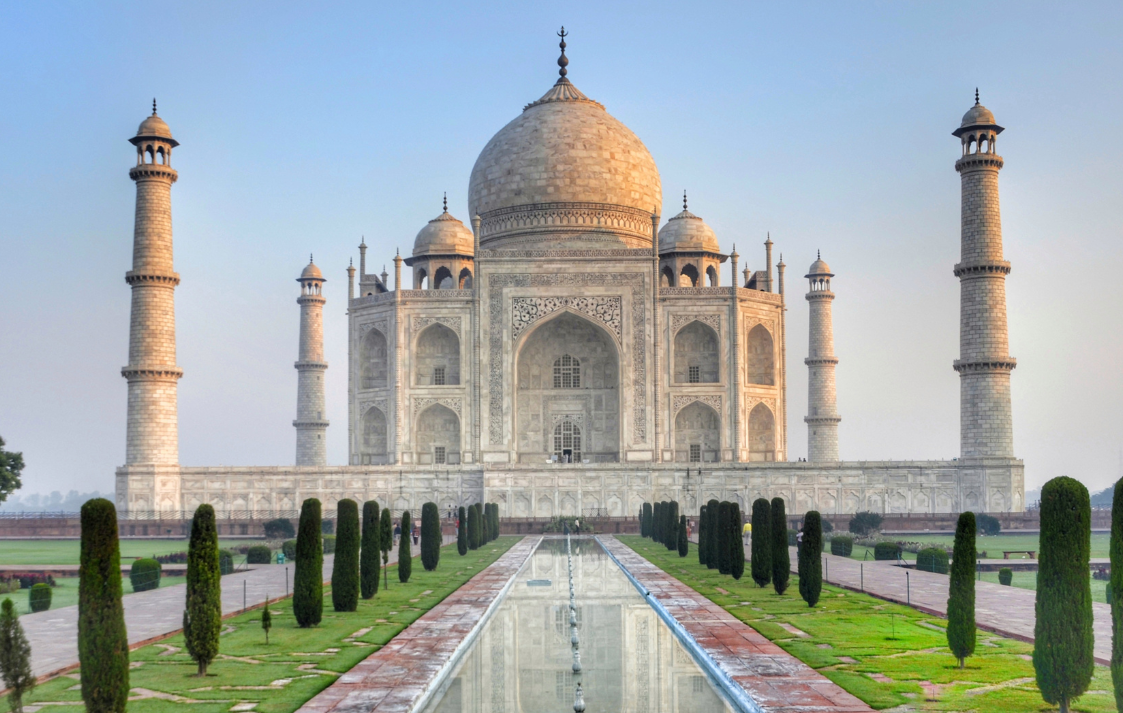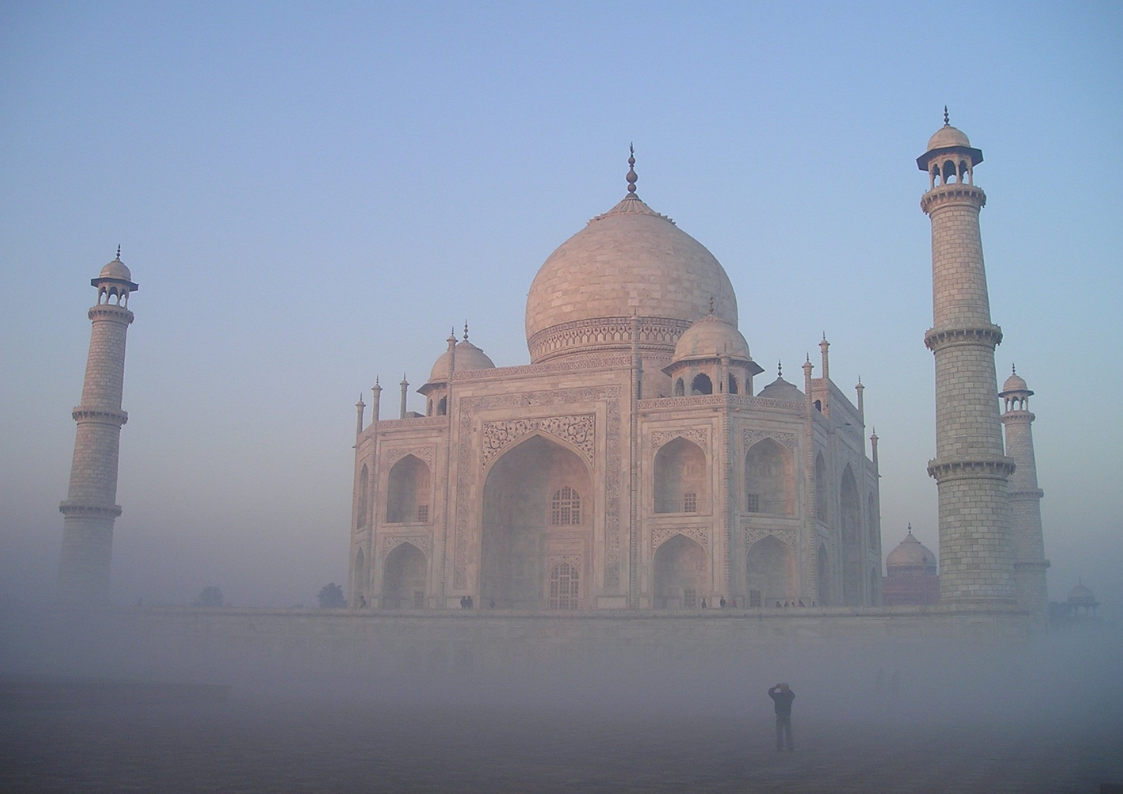One structure stands indisputable above the others when the subject of India's architectural wonders is brought up: the Taj Mahal. Millions of people are drawn to this ethereal white marble mausoleum each year as a representation of unending love. Our guide guarantees to enhance your experience, whether you're considering a trip or are just thinking about this UNESCO World Heritage site.

A Glimpse into History
The Taj Mahal was built by Shah Jahan, the fifth Mughal emperor, as a tribute to his adored wife Mumtaz Mahal. When they were married in 1612, their love story officially began. They remained inseparable until her unexpected death in 1631, when they were expecting their fourteenth child.
Shah Jahan was devastated by her passing and desired to preserve her memory. Therefore, the Taj Mahal was intended to be more than just a tomb but also a symbol of unending love.
Design & Construction
Materials for the project came from all around Asia and India when construction started in 1632. The building of this tomb required the combined work of about 20,000 artists, craftsmen, and workers over the course of about 22 years.
This masterpiece was designed by Ustad Ahmad Lahori, who integrated Persian, Islamic, and Indian architectural elements. Four minarets defend the corners as the central dome, which is surrounded by four smaller domes, is raised above a square platform.White marble was intricately inlaid by artisans with precious and semi-precious gemstones. The cenotaphs of Mumtaz Mahal and Shah Jahan are located inside, and Quranic phrases are etched all over them.
The Legacy
The Taj Mahal is more than just a stunning building; it is a symbol of unwavering love and brilliant design. It continues to attract tourists from all over the world, encouraging them to travel back in time and experience the splendor of the Mughal Empire. It was designated a UNESCO World Heritage Site in 1983.
In conclusion, the Taj Mahal continues to stand as a tribute to the magnificence of Mughal construction and the intense feelings of a bereaved ruler. Its beauty and symbolism have endured throughout the ages, enthralling people today as much as ever.
Gardens & Outbuildings
The tomb is surrounded by a Charbagh, or Mughal Garden, which divides into four quadrants to represent the Islamic notion of paradise. A mosque and its mirror counterpart, a guest house, are located to the west and east, respectively, of the Taj Mahal.

Best Time to Visit
To bask in the Taj's full glory, consider visiting during the cooler months of October to March. Dawn and dusk visits offer mesmerizing views, with the changing hues of the sky reflecting off its marble surface.
Unknown Facts about Taj Mahal
Essential Tips for Tourists
- Dress Modestly: India is a country steeped in traditions. When visiting, it's respectful to wear clothes covering your shoulders and knees.
- Ticketing: Purchase tickets in advance or arrive early, especially during tourist season.
- Avoid Mondays: The Taj Mahal remains closed on Mondays, so plan accordingly!
- Hire a Guide: To truly grasp the monument's history, consider hiring an authorized guide. Their tales bring the cold marble to life.
Unknown Facts about Taj Mahal
The Taj Mahal, despite its iconic status and vast documentation, holds many lesser-known facts that add layers to its intriguing history. Here are some lesser-discussed facts about this legendary monument:
- Different Hues at Different Times: The Taj Mahal is known to exhibit different colors at various times of the day. It appears pinkish in the early morning, milky white in the afternoon, and golden under the moonlight.
- Protective Measures During Wars: During World War II and later wars, the government undertook efforts to protect the Taj from potential bombing raids. They erected scaffolding around the dome to make it less recognizable from the air.
- The Skewed Minarets: The four minarets surrounding the main tomb lean slightly outwards rather than standing straight. This intentional architectural design ensures that in the event of a collapse, the pillars would fall away from the central tomb.
- A Fading Facade: Over the years, pollution has been affecting the white marble of the Taj Mahal, causing it to yellow. Efforts are being made to restrict pollution in the nearby areas to preserve the monument's brilliance.
- The Myth of a Black Taj: There's a legend that Shah Jahan intended to build a mirror image of the Taj Mahal across the Yamuna River in black marble as his tomb. However, this has no substantial historical evidence.
- An Optical Illusion: As you walk towards the main gate of the Taj Mahal, the monument appears to keep increasing in size, but as you walk away, it seems to shrink, thanks to the intricate play of the architecture.
- The Floral Motifs: The Taj Mahal is adorned with 28 types of precious and semi-precious stones sourced from all over Asia. These stones were intricately carved into the white marble, forming the beautiful floral patterns and designs.
- A Changing Landscape: The British, during their rule, altered the landscape around the Taj. They replaced the vast expanse of lush gardens with the now seen lawns, as it was emblematic of the gardens back in England.
- The Light Illusion: The tombs of Mumtaz Mahal and Shah Jahan are intricately designed. When light enters the main chamber, it falls in such a way that the tombs are illuminated while the intricately designed lattice framework remains dark, creating a mystical atmosphere.
- Rare Manuscripts: The inscriptions on the Taj Mahal, beautifully crafted with black marble on white, aren’t merely decorative. They consist of verses from the Quran and are composed by calligrapher Amanat Khan, whose name is also inscribed on the monument.
These facts, though lesser-known, add to the mystique and allure of the Taj Mahal, enhancing its reputation not just as a symbol of love, but also as an architectural wonder filled with secrets waiting to be uncovered.
Photography Tips
While the iconic dome offers a classic snapshot, the gardens and surrounding structures, like the mosque and guest house, provide unique angles. Remember, tripods and drones are not allowed.

Nearby Attractions
The Taj Mahal, located in Agra, is surrounded by several other historical and cultural landmarks. If you're planning a visit, it's worth setting aside some time to explore these nearby attractions:
- Agra Fort: Only about 2.5 kilometers from the Taj Mahal, this massive red sandstone fort serves as another UNESCO World Heritage site in Agra. Built by Emperor Akbar, it later became the residence of his grandson, Shah Jahan, who is believed to have been imprisoned here by his son, Aurangzeb. From certain areas of the fort, you can get a distant view of the Taj Mahal.
- Mehtab Bagh: Located directly across the Yamuna River from the Taj Mahal, this "Moonlight Garden" offers a stunning and less crowded view of the Taj, especially during sunset. The garden was initially designed by Emperor Babur, the founder of the Mughal dynasty.
- Itmad-ud-Daulah's Tomb: Often referred to as the "Baby Taj", this is the tomb of Mirza Ghiyas Beg, the grandfather of Mumtaz Mahal. This monument is regarded as a precursor to the Taj Mahal in terms of its design and the extensive use of marble.
- Sikandra: Located around 10 kilometers from the Taj Mahal, Sikandra is where Emperor Akbar's mausoleum is situated. It's a blend of Hindu, Christian, Islamic, Buddhist, and Jain themes, showcasing Akbar's secular outlook.
- Jama Masjid: This large mosque was built by Shah Jahan's daughter, Princess Jahanara Begum. It's located in the heart of Agra and is an excellent example of Mughal architecture.
- Guru Ka Tal: A historical Sikh pilgrimage site dedicated to the ninth Guru, Guru Tegh Bahadur. Originally a reservoir meant to collect rainwater, it's now an intricately carved, red stone gurudwara (Sikh temple).
- Fatehpur Sikri: About 40 kilometers from Agra, this city was the Mughal Empire's capital for a short time under Emperor Akbar's reign. It's known for its red sandstone architecture, including the famous Buland Darwaza, and is also a UNESCO World Heritage site.
- Ram Bagh: This is the oldest Mughal Garden in India, built by Emperor Babur in 1528. It's a Persian garden and was designed as a cool retreat with numerous fountains and water channels.
- Shopping and Cuisine: Agra is also famous for its marble inlay work, leather goods, and sweets. Exploring local markets like Kinari Bazaar, Sadar Bazaar, and Shah Market can be a delightful experience. Don't forget to try the local delicacy, 'Petha'.
Exploring these nearby attractions will provide a comprehensive understanding of Agra's historical and cultural significance, making your visit all the more enriching.
Sustainability Matters
To preserve its beauty for future generations, respect the monument. Here are sustainability steps that tourists visiting the Taj Mahal can adopt:
- Respect the Monument: Adhere to guidelines laid out for visitors. Avoid touching walls or inscriptions, as the oils and dirt from hands can erode the stone over time.
- Limit Plastic Usage: Carry reusable water bottles, bags, and other essentials. If you do use plastic, ensure you dispose of it responsibly, keeping in mind that Agra does not have extensive waste recycling facilities.
- Use Eco-Friendly Transportation: Opt for cycle rickshaws, electric auto-rickshaws, or carpool with fellow tourists when exploring Agra. This reduces the carbon footprint and decreases air pollution, which affects the marble of the Taj Mahal.
- Maintain Silence: Especially in the inner chambers, keeping noise levels down ensures a serene atmosphere and respects other visitors.
- Support Conservation Efforts: Many organizations work towards the preservation of the Taj Mahal. Consider donating or even just sharing information about these efforts to raise awareness.
In Conclusion
The Taj Mahal serves as a living example of the value of love above all else and the enduring beauty of art and architecture. It continues to hold a unique fascination as a representation of both Mughal grandeur and India's vast historical tapestry. The white marble mausoleum tells a moving tale of love, loss, and legacy as it reflects the sky's many colours.
Beyond its stunning appearance, it serves as a reminder of human aspiration and the timeless nature of beauty. The Taj Mahal, which continues to enchant tourists from all over the world with its grandeur, is recognized not only as a masterpiece of Indian architecture but also as a symbol of enduring love and devotion. It is up to us all to value, protect, and maintain this monument for upcoming generations in order to ensure that its story of love endures for all of time.
